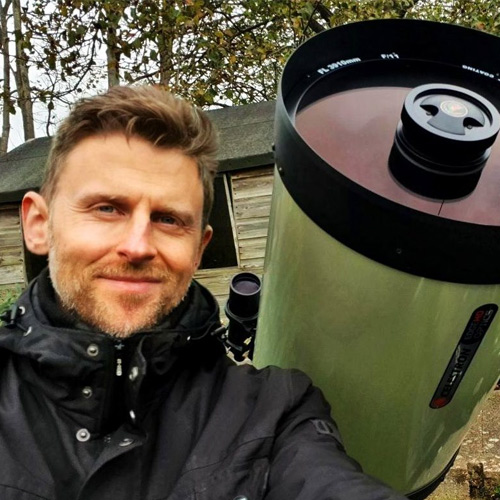What are Dobsonian Telescopes?
Discover what Dobsonian telescopes are as we take you through their design and widespread popularity among astronomers.
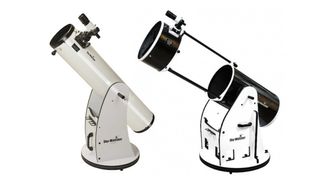
A Dobsonian telescope is just one of a wide range of telescopes available today. They come in many shapes and sizes with multiple designs to produce clearer and sharper night sky views. Whether you're a beginner looking for a lightweight refractor or are a serious astro lover with a passion of huge reflectors, there's a telescope available for every budget and skill level.
The Dobsonian telescope design remains hugely popular with amateur astronomers. It is a low-cost design Newtonian reflector and it set a paradigm shift in amateur astronomy back when it was first made popular back in the 1960s by American telescope maker, John Dobson. Dobsonians are low-budget, user-friendly and offered the possibility of owning a large aperture telescope at home.
If you're interested in investing in a telescope yourself why not read through our guide to the best telescopes, get the young ones involved with the best telescopes for kids or, if you're just starting out, take a look at some of the best telescopes for beginners. Alternatively, for the budget-conscious, we've rounded up the best telescope deals available today.
But when it comes to Dobsonians, another important feature of Dobson's design was that it was easy for amateurs to build a Dobsonian telescope themselves, and many did just that. My first large aperture telescope at around age 13 was a homemade wooden 25cm Dobsonian (which worked wonderfully well.)
Today the design remains hugely popular, especially for those who enjoy visual observing. In this piece, we take a more detailed look at the design and suggest some affordable options worth looking at.
The Classic Dobsonian Design
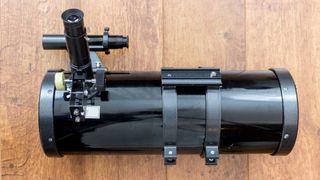
The Newtonian reflecting telescope has been in use for centuries since its invention by Issac Newton back in 1668. Unlike refracting telescopes (whose lenses are very expensive in larger sizes) the Newtonian reflector offers the possibility of owning a large aperture telescope without having to break the bank.
The Dobsonian design offers the Newtonian reflector on a simplistic Alt-Az mount whereby the user can push/pull the telescope in a horizontal/vertical motion to locate targets. Most low-cost Dobsonian telescopes are not driven meaning they are only suitable for visual observing. Higher cost models come with dual axis drive systems and go-to ability though these are significantly more expensive. The right choice of telescope, of course, depends upon what the user wants to achieve.
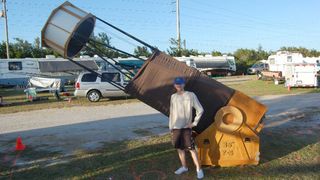
With the telescope being a Newtonian design, it means the optical system must be collimated to perform at its very best. This can be a confusing and frustrating process for the beginner as it requires time and patience to achieve. Fortunately, most come with instructions on how to collimate the telescope accurately and there is plenty of further information online for those struggling.
A 10-inch to 12-inch (25-30cm) Dobsonian can give a lifetime of viewing enjoyment and will offer significantly more impressive views than for example a 4-inch or 5-inch (10-13cm) refracting telescope, especially under dark/steady skies. I can recall many fine views through Dobsonian telescopes over the years.
Dobsonian's are generally employed by visual observers who have a keen interest in the visual observation of celestial targets. They are especially popular among those who enjoy observing galaxies and nebulae as very large apertures can be fabricated, up to around 40-inch (100cm) in some cases. Objects can be quickly located and they are great for hopping from one target to the next.
The Modern Dobsonian
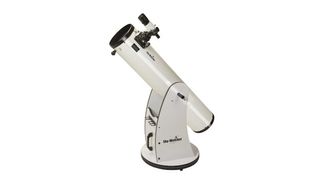
Unlike the simple homemade offering I used back in my teenage years, the modern incarnation of the Dobsonian design is an impressive instrument, to say the least. While the low-cost simple design remains widely used, manufacturers now produce fully computerized Dobsonian designs that can be employed for a wide range of different applications well beyond the pleasures of visual observing.
Aperture sizes vary greatly but typically come in sizes ranging between 6-inch (15cm) and 20-inch (50cm.) Obviously, telescopes at the larger end of the scale become increasingly big and heavy, though most do remain portable as they can be easily assembled/disassembled.
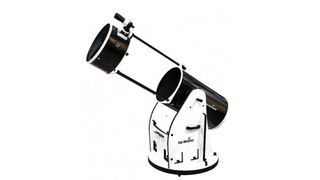
One especially notable point in the Dobsonian design is it allows the amateur the possibility of owning a really large telescope. Many serious visual deep-sky observers own Dobsonian telescopes, with many owning apertures in the 20-inch (50cm) to 30-inch (70cm) range. Such a telescope allows for stunning views of nebulae and galaxies that smaller telescopes simply cannot replicate.
These modern designs offer a wide range of sophisticated features. Full computerized go-to slewing, dual-axis tracking, high-quality focusers and optics. Companies such as Skywatcher have made the modern Dobsonian an increasingly popular choice for amateur astronomers worldwide. They offer good optical quality and a wide range of different features at realistic prices — which given the financial squeeze being felt at the current time, will be of prime consideration to many.
The modern Dobsonian can also be employed for serious astrophotography, especially imaging of the moon and planets where they are often used to good effect. For longer exposure work on a telescope, it's possible to mount a Dobsonian upon an equatorial platform allowing the user to have the telescope polar-aligned.
- More top deals: Telescopes on Amazon
- See the latest discounts: Telescope at Walmart
- Browse the sales: Telescopes at Best Buy
Final thoughts
The Dobsonian is a fantastic choice of telescope, especially for those starting out. I keenly recall many fine views through Dobsonian telescopes when I first began my journey into astronomy more than thirty years ago. John Dobson's revolutionary design changed the face of amateur astronomy forever and opened up the possibility of large telescope ownership to the masses.
While the Dobsonian has certainly benefited from the advances of modern technology since it was first developed back in the 1960s, the core principle of what makes them such great telescopes remains. Anyone with a keen interest in observing the night sky should seriously consider one, especially if they are a keen visual observer. They remain the only design where a truly large telescope is within reach of many, and as I can attest to when it comes to astronomy, aperture counts!
Join our Space Forums to keep talking space on the latest missions, night sky and more! And if you have a news tip, correction or comment, let us know at: community@space.com.
Get the Space.com Newsletter
Breaking space news, the latest updates on rocket launches, skywatching events and more!
Damian A. Peach FRAS is a British amateur astronomer, astrophotographer, lecturer and author. Best known for his photographs of a wide variety of astronomical objects. His career in the field spans over thirty years. Peach's passion for Astronomy first began in 1988 inspired by books in his school library. Later he joined the British Astronomical Association (BAA) in 1996 and since then has contributed large amounts of observations to the various observing sections and also written and co-authored many papers in the organization's journal. He was awarded the organization's prestigious Merlin Medal in 2006. The same year he was also awarded the Association of Lunar and Planetary Observers (ALPO) Walter H. Haas award for his contributions. Peach has provided astronomical images for magazines and books throughout his career. His images have been featured in Astronomy Magazine, Sky & Telescope, Astronomy Now & The Sky at Night. He has also authored articles on astrophotography for these magazines. Peach has also been a co-author on several professional scientific papers on planetary astronomy, especially regarding work on Mars and Jupiter. He was one of only a few amateur astronomers to have work featured as part of the national Explorers of the Universe exhibition at the Royal Albert Hall in 2007. His work has also appeared at the Edinburgh Science Festival, and The Royal Greenwich Observatory. Peach's work has also been used by NASA and ESA to illustrate what ground-based telescopes can achieve in photographing the planets, and the support they can provide to professional space probe missions.
